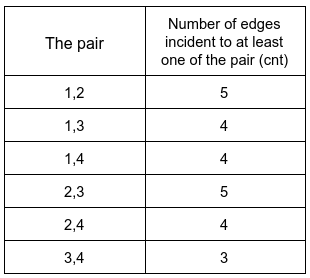You are given an undirected graph represented by an integer n, which is the number of nodes, and edges, where edges[i] = [ui, vi] which indicates that there is an undirected edge between ui and vi. You are also given an integer array queries.
The answer to the jth query is the number of pairs of nodes (a, b) that satisfy the following conditions:
a < bcntis strictly greater thanqueries[j], wherecntis the number of edges incident toaorb.
Return an array answers such that answers.length == queries.length and answers[j] is the answer of the jth query.
Note that there can be repeated edges.
Example 1:

Input: n = 4, edges = [[1,2],[2,4],[1,3],[2,3],[2,1]], queries = [2,3] Output: [6,5] Explanation: The number of edges incident to at least one of each pair is shown above.
Example 2:
Input: n = 5, edges = [[1,5],[1,5],[3,4],[2,5],[1,3],[5,1],[2,3],[2,5]], queries = [1,2,3,4,5] Output: [10,10,9,8,6]
Constraints:
2 <= n <= 2 * 1041 <= edges.length <= 1051 <= ui, vi <= nui != vi1 <= queries.length <= 200 <= queries[j] < edges.length
Difficulty:
HardLock:
NormalCompany:
AmazonProblem Solution
1782-Count-Pairs-Of-NodesAll Problems:
Link to All Problems
All contents and pictures on this website come from the Internet and are updated regularly every week. They are for personal study and research only, and should not be used for commercial purposes. Thank you for your cooperation.